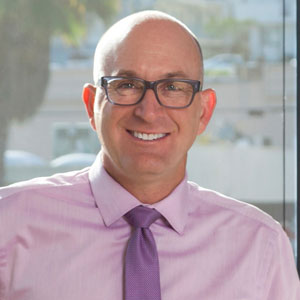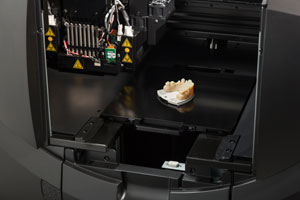By Laura Thill
Cone beam technology and 3D printing continue to be a game-changer for dentists and patients alike.

In nearly the time it takes to make a pot of coffee and retrieve the morning paper from the driveway, some dentists can place an implant. While there’s no way to guarantee a perfect cup of coffee, however, that implant’s going to be darn close to perfect, if not spot-on.
Cosmetic and reconstructive specialist Michael Fulbright, DDS, owner of Fulbright Cosmetic and Reconstructive Dentistry, Redondo Beach, California, spends much of his day in surgery. His services range from implants and full-mouth rehabilitation to porcelain veneers, periodontal care and treatment for TMJ disorders and sleep apnea. “If there’s one thing that has made my patients’ life better – and my life easier – it has been cone beam technology, or 3D cat scans,” he says. “That combined with my CEREC CAD/CAM technology, procedures have gotten easier and less expensive, with better results.”
Fulbright, in fact, had just completed an implant procedure shortly before taking time to discuss surgical advances that have changed the dental industry for the better. “With my Gallileos cone beam and CEREC, I was able to plan this morning’s surgery ahead of time and place the implant exactly where it needed to be using a surgical guide fabricated right in my office.” Not long ago, it would have been impossible to get an unobstructed view to determine whether the patient had enough bone height to avoid the mandibular nerve, he points out. Not so today.
 “In the old days, using 2D X-ray technology, I would have to place implants freehand. Although I have placed many freehand implants successfully, the predictability and precision of guided implants has given us more confidence and has made the procedure more efficient. The patient experience and case acceptance have increased dramatically with the patient being able to visualize and be a part of the planning process. With regard to our digital scanning technology (CEREC) to take impressions versus the old putty impressions, there really is no comparison. Patients love the fact that they don’t have to have a goopy, gaggy impression made, and the accuracy of the impression and fit of the subsequent crown is superior.”
“In the old days, using 2D X-ray technology, I would have to place implants freehand. Although I have placed many freehand implants successfully, the predictability and precision of guided implants has given us more confidence and has made the procedure more efficient. The patient experience and case acceptance have increased dramatically with the patient being able to visualize and be a part of the planning process. With regard to our digital scanning technology (CEREC) to take impressions versus the old putty impressions, there really is no comparison. Patients love the fact that they don’t have to have a goopy, gaggy impression made, and the accuracy of the impression and fit of the subsequent crown is superior.”
“Today, I approach the procedure using reverse engineering, first planning the ideal crown and then planning the implant. Next, using a surgical guide sleeve over the missing tooth, I position the drill in the sleeve and can get within microns of the mandibular nerve or sinus, confident I won’t hit it.” Surgical times have been reduced from an hour to about 10 or 15 minutes, he adds. His practice runs more efficiently and his patients and dental team are happier.
Furthermore, even smaller dental offices are able to accommodate cone beam equipment. “The cone beam footprint is small enough that it should fit in most dental offices,” he says.
A window to the future
If cone beam has changed the face of dental surgery, 3D printing has opened a window to the future. “3D printing definitely has changed – and will continue to improve – the way I work,” says Fulbright. “My CEREC digital scanner ensures I get the most accurate impression possible, which I can send to a lab or print a model in-office with my 3D printer. I believe this is where every dental practice is headed. I use my printer to print models for Invisalign-type aligners, sleep apnea appliances and nightguards.
“3D printers have come down in price tremendously,” he continues. And, because he is able to work more accurately and efficiently, his printer has practically paid for itself, he notes. “So, I don’t need to raise my fees to reflect the cost of the equipment. I don’t pass that cost on to my patients.”
3D printing is still relatively new, according to Fulbright. “It’s really just getting started,” he says. “Today, we only basically print plastic. As the materials catch up to the technology, I expect we’ll eventually move away from milling and start printing porcelain crowns and implant abutments. The sky is the limit.”
Expanding roles
Advances in surgical technology have led to new and expanding roles for dental assistants. Indeed, as more and more can be accomplished in the dental office, dental assistants no longer take a back-seat to the rest of the team. “Dental assistants’ jobs have changed tremendously,” says Michael Fulbright, DDS, owner of Fulbright Cosmetic and Reconstructive Dentistry, Redondo Beach, California. “The dental assistants are the ones who are learning the software involved in milling, planning and 3D printing. I always complete the training with my team, but it’s my dental assistants who are using these machines day in and day out!”
And this is a good thing, he adds. “Patients know and trust their dental assistants – often more so than their dentist. For patients, this technology means shorter chair times and less re-dos.”
Editor’s note: Michael Fulbright, DDS, owner of Fulbright Cosmetic and Reconstructive Dentistry (Redondo Beach, CA), offers restorative options such as dental implants and full-mouth rehabilitation, as well as a full range of general and cosmetic dentistry procedures. In addition, he is dedicated to helping individuals who suffer from obstructive sleep apnea. Dr. Fulbright is also very involved in giving back to his community. He has helped restore the lives of domestically abused men and women through the Give Back a Smile Foundation, as well as volunteered through Remote Area Medical (RAM), the Beacon House and various community causes.

